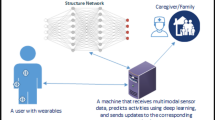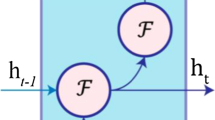Abstract
Remote monitoring of patients is considered as one of the reliable alternatives to healthcare solutions for elderly and/or chronically ill patients. Further, monitoring interaction with people plays an important role in diagnosis and in managing patients that are suffering from mental illnesses, such as depression and autism spectrum disorders (ASD). In this paper, we propose the Kinect sensor-based interaction monitoring system between two persons using the Bidirectional long short-term memory neural network (BLSTM-NN). Such model can be adopted for the rehabilitation of people (who may be suffering from ASD and other psychological disorders) by analyzing their activities. Medical professionals and caregivers for diagnosing and remotely monitoring the patients suffering from such psychological disorders can use the system. In our study, ten volunteers were involved to create five interactive groups to perform continuous activities, where the Kinect sensor was used to record data. A set of continuous activities was created using random combinations of 24 isolated activities. 3D skeleton of each user was detected and tracked using the Kinect and modeled using BLSTM-NN. We have used a lexicon by analyzing the constraints while performing continuous activities to improve the performance of the system. We have achieved the maximum accuracy of 70.72%. Our results outperformed the previously reported results and therefore the proposed system can further be used in developing internet of things (IoT) Kinect sensor-based healthcare application.
















Similar content being viewed by others
References
A P Association et al (1994) Diagnostic and statistical manual of mental disorders (dsm). American psychiatric association, Washington, DC, pp 143–147
A P Association et al (2000) Diagnostic and statistical manual of mental disorders, revised, vol 943. American Psychiatric Association Washington DC, p 2000
Atzori L, Iera A, Morabito G (2010) The internet of things: a survey. Comput Netw 54(15):2787–2805
Baccouche M, Mamalet F, Wolf C, Garcia C, Baskurt A (2011) Sequential deep learning for human action recognition. In: Human Behavior Understanding, pp 29–39
Bloom V, Makris D, Argyriou V (2012) G3d: a gaming action dataset and real time action recognition evaluation framework. In: Conference on computer vision and pattern recognition workshops, pp 7–12
Chen M, Zhang Y, Li Y, Hassan MM, Alamri A (2015) Aiwac: affective interaction through wearable computing and cloud technology. IEEE Wirel Commun 22(1):20–27
Cheok MJ, Omar Z, Jaward MH (2017) A review of hand gesture and sign language recognition techniques. Int J Mach Learn Cybern. https://doi.org/10.1007/s13042-017-0705-5
Dell’Acqua P, Klompstra LV, Jaarsma T, Samini A (2013) An assistive tool for monitoring physical activities in older adults. In: 2nd international conference on serious games and applications for health, pp 1–6
Feng S, Murray-Smith R, Ramsay A (2017) Position stabilisation and lag reduction with gaussian processes in sensor fusion system for user performance improvement. Int J Mach Learn Cybern 8(4):1167–1184
Gaglio S, Re GL, Morana M (2015) Human activity recognition process using 3-d posture data. IEEE Trans Hum Mach Syst 45(5):586–597
Garcia JA, Pisan Y, Tan CT, Navarro KF (2014) Assessing the kinects capabilities to perform a time-based clinical test for fall risk assessment in older people. In: International conference on entertainment computing, pp 100–107
Ghose A, Sinha P, Bhaumik C, Sinha A, Agrawal A, Dutta Choudhury A (2013) Ubiheld: ubiquitous healthcare monitoring system for elderly and chronic patients. In: Conference on pervasive and ubiquitous computing adjunct publication, pp 1255–1264
Graves A, Liwicki M, Fernández S, Bertolami R, Bunke H, Schmidhuber J (2009) A novel connectionist system for unconstrained handwriting recognition. IEEE Trans Pattern Anal Mach Intell 31(5):855–868
Graves A, Schmidhuber J (2005) Framewise phoneme classification with bidirectional LSTM and other neural network architectures. Neural Netw 18(5):602–610
Holzinger A, Röcker C, Ziefle M (2015) Smart health: open problems and future challenges, vol 8700. Springer, Switzerland
Ji J, Scholten P, Zhao Q (2014) Support to self-diagnosis with awareness. Int J Mach Learn Cybern 5(4):647–658
Kulkarni K, Evangelidis G, Cech J, Horaud R (2015) Continuous action recognition based on sequence alignment. Int J Comput Vis 112(1):90–114
Kumar P, Gauba H, Roy PP, Dogra DP (2016) Coupled hmm-based multi-sensor data fusion for sign language recognition. Pattern Recognit Lett 86:1–8. https://doi.org/10.1016/j.patrec.2016.12.004
Kumar P, Saini R, Roy P, Dogra D (2017) A bio-signal based framework to secure mobile devices. J Netw Comput Appl 89:62–71
Kumar P, Saini R, Roy PP, Dogra DP (2016) 3d text segmentation and recognition using leap motion. In: Multimedia tools and applications, pp 1–20
Lanata A, Valenza G, Nardelli M, Gentili C, Scilingo EP (2015) Complexity index from a personalized wearable monitoring system for assessing remission in mental health. IEEE J Biomed Health Inf 19(1):132–139
Lefebvre G, Berlemont S, Mamalet F, Garcia C (2013) Blstm-rnn based 3d gesture classification. In: International conference on artificial neural networks, pp 381–388
Miranda JC, Sousa AA, Fernandes T, Orvalho VC (2011) Interactive technology: teaching people with autism to recognize facial emotions. In: Autism spectrum disorders—from genes to environment. InTech
Mukherjee S, Saini R, Kumar P, Roy PP, Dogra DP, Kim BG (2017) Fight detection in hockey videos using deep network. J Multimed Inf Syst 4(4):225–232
Mukhopadhyay SC (2015) Wearable sensors for human activity monitoring: a review. IEEE Sens J 15(3):1321–1330
Murali S, Rincon F, Atienza D (2015) A wearable device for physical and emotional health monitoring. In:Computing in Cardiology Conference, pages 121–124
Parajuli M, TranD, Ma W, Sharma D (2012) Senior health monitoring using kinect. In: 4th international conference on communications and electronics, pp 309–312
Rabiner L, Juang B (1986) An introduction to hidden markov models. IEEE ASSP Mag 3(1):4–16
Saini R, Kumar P, Roy PP, Dogra DP (2018) A novel framework of continuous human-activity recognition using kinect. Neurocomputing 311:99–111
Sebestyen G, Hangan A, Oniga S, Gál Z (2014) ehealth solutions in the context of internet of things. In: International conference automation, quality and testing, robotics, pp 261–267
Sempena S, Maulidevi NU, Aryan PR (2011) Human action recognition using dynamic time warping. In: International conference on electrical engineering and informatics, pp 1–5
Sung J, Ponce C, Selman B, Saxena A (2012) Unstructured human activity detection from rgbd images. In: 2012 IEEE international conference on robotics and automation, pp 842–849
Wang J, Liu Z, Wu Y, Yuan J (2012) Mining actionlet ensemble for action recognition with depth cameras. In: Conference on computer vision and pattern recognition, pp 1290–1297
Wang L (2016) Recognition of human activities using continuous autoencoders with wearable sensors. Sensors 16(2):189
Ward JA, Lukowicz P, Troster G, Starner TE (2006) Activity recognition of assembly tasks using body-worn microphones and accelerometers. IEEE Trans Pattern Anal Mach Intell 28(10):1553–1567
Yun K, Honorio J, Chattopadhyay D, Berg TL, Samaras D(2012) Two-person interaction detection using body-pose features and multiple instance learning. In: Conference on computer vision and pattern recognition workshops, pp 28–35
Zhang Z (2012) Microsoft kinect sensor and its effect. IEEE Multimed 19(2):4–10
Author information
Authors and Affiliations
Corresponding author
Ethics declarations
Conflict of interest
The authors declare that they have no conflict of interest.
Ethical approval
All procedures performed in studies involving human participants were in accordance with the ethical standards of the institution.
Additional information
Publisher's Note
Springer Nature remains neutral with regard to jurisdictional claims in published maps and institutional affiliations.
Rights and permissions
About this article
Cite this article
Saini, R., Kumar, P., Kaur, B. et al. Kinect sensor-based interaction monitoring system using the BLSTM neural network in healthcare. Int. J. Mach. Learn. & Cyber. 10, 2529–2540 (2019). https://doi.org/10.1007/s13042-018-0887-5
Received:
Accepted:
Published:
Issue Date:
DOI: https://doi.org/10.1007/s13042-018-0887-5




